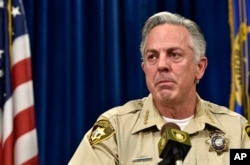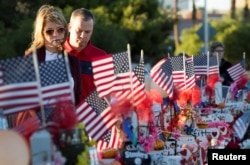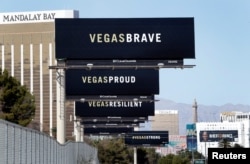The revised timeline given by investigators for the Las Vegas massacre raises questions about whether better communication might have allowed police to respond more quickly and take out the gunman before he could kill and wound so many people.
On Monday, Sheriff Joe Lombardo said Stephen Paddock shot and wounded a Mandalay Bay hotel security guard outside his door and sprayed 200 bullets down the hall six minutes before he opened fire October 1 from his high-rise suite on a crowd at a country music festival below.
That was a different account from the one police gave last week: that Paddock shot the unarmed guard, Jesus Campos, after unleashing his barrage of fire on the crowd, where 58 people were killed and hundreds injured.
The sheriff had previously hailed Campos as a "hero" whose arrival in the hallway may have led Paddock to stop firing. But on Monday, Lombardo said he didn't know what prompted Paddock to end the gunfire and take his own life.
How crucial were the minutes that elapsed before the massacre began?
"This changes everything," said Joseph Giacalone, a professor at John Jay College of Criminal Justice and a former New York City police sergeant. "There absolutely was an opportunity in that time frame that some of this could've been mitigated."
Giacalone added: "By engaging the shooter ahead of time during this event, it could've saved a lot of heartache."
Campos reported to hotel security dispatchers that he was shot before Paddock opened fire on the crowd, Assistant Sheriff Tom Roberts told the Los Angeles Times. Campos ran down the hall, away from Paddock's room, after he was shot and may have used both his radio and a hallway phone to call for help, he said.
It wasn't clear exactly what time Campos called for help or whether the hotel had relayed the information about the shooting to police. Las Vegas police did not respond to questions from The Associated Press about whether hotel security or anyone else in the hotel called 911 to report the hallway shooting.
"Our officers got there as fast as they possibly could, and they did what they were trained to do," another Las Vegas assistant sheriff, Todd Fasulo, said Tuesday.
MGM Resorts International, which owns the Mandalay Bay, has referred all inquiries to an outside crisis management team, which again declined to comment for the record Tuesday. A representative for Campos' union didn't immediately respond to a message seeking comment.
But the sheriff has said that Las Vegas police officers searching the hotel for the gunman during the attack did not learn the guard had been shot until they got off the elevator on the 32nd floor and met him in the hallway.
Nicole Rapp, whose mother was knocked to the ground and trampled by panicked concertgoers as bullets rained from above, said she's "having a hard time wrapping my head around" why police changed the timeline of the shooting.
"It's very confusing to me that they are just discovering this a week later," she said. "How did we not know this before? It's traumatic for the victims and their families not to be sure of what happened."
Fasulo explained the change in the timeline by saying that dozens of investigators have been using different sources of information — including surveillance video, computers, police body cameras, cellphones and interviews — and that not all clocks were in sync.
Last week, police said Paddock had shot at concertgoers for 10 minutes and stopped firing around 10:15 p.m. The first officers arrived on the 32nd floor at 10:17 p.m. and encountered the wounded guard at the elevator bank about a minute later, police said.
The security guard had been responding to a door alarm on the floor when he heard an odd drilling sound, Undersheriff Kevin McMahill told KNPR on Tuesday. That was when Paddock fired hundreds of rounds at the guard and a maintenance man, McMahill said.
Paddock had power tools and was trying to drill a hole in a wall, perhaps to mount another of the security cameras he set up around him, or to point a rifle through, but he never completed the work, Lombardo said. He also drilled holes and bolted a metal bar to try to prevent the opening of an emergency exit door near his room.
The six minutes that transpired between the hallway shooting and the start of the gunman's fusillade wouldn't have been enough time for officers to stop the attack, said Ron Hosko, a former FBI assistant director who has worked on SWAT teams. Rather than rush in without a game plan, police would have been formulating the best response to the barricaded gunman, he said.
"Maybe that's enough time to get the first patrolman onto the floor, but the first patrolman is not going to go knock on that customer's door and say, 'What's going on with 200 holes in the door?' " Hosko said.
McMahill defended the hotel and said the encounter that night between Paddock and the security guard and maintenance man disrupted the gunman's plans. Paddock fired more than 1,000 shots and had more than 1,000 rounds left in his room, the undersheriff said.
"I can tell you I'm confident that he was not able to fully execute his heinous plan and it certainly had everything to do with being disrupted," McMahill said. He added: "I don't think the hotel dropped the ball."












